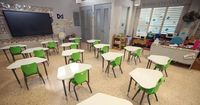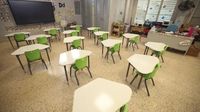On the sun-drenched island of Culebra, Puerto Rico, the summer heat is more than just uncomfortable—it’s a daily challenge for students and teachers alike. Last month, as temperatures soared into the upper 80s Fahrenheit, children attending a summer program at the local public school scattered in search of relief. Some, like third grader Zedrik, sat beside bushes hoping for shade, while others, such as ninth grader Kenneth, retreated to the library. Eighth grader Nayla found solace in the director’s office, where a lone air conditioner offered a brief escape from the oppressive warmth. But for most, the options were limited: ceiling fans whirred at half strength, and other cooling devices sat idle, casualties of the island’s ongoing energy crisis.
Puerto Rico’s schools are no strangers to adversity. The devastation wrought by Hurricane Maria in 2017 and a series of earthquakes in 2020 left many educational facilities in ruins. According to collaborative reporting by Centro de Periodismo Investigativo and The Associated Press, efforts to rebuild have been slow, leaving schools ill-equipped to face the new threat of increasingly frequent and intense heat waves. The result? Students and teachers are left to endure stifling classrooms, with little more than guidelines suggesting they relocate to better-ventilated or air-conditioned spaces—spaces that, more often than not, simply don’t exist.
“In the afternoon, classes have to be much more strict than in the morning to keep students’ attention. Otherwise the class just becomes, ‘It’s so hot, mister. It’s so hot,’” reported José Quintana, a math teacher at Escuela Ecológica in Culebra, who himself suffered heat exhaustion in 2023. The psychological and physical toll of the heat is well-documented. As noted by Nellie Zambrana, a school psychologist and professor at the University of Puerto Rico, heat acts as a stressor, triggering anxiety and reducing memory capacity. Research from UNICEF underscores that children, especially the youngest, are particularly vulnerable: they sweat less and have faster metabolisms, making them more prone to heat stress.
The numbers tell a stark story. In 2024 alone, the eastern educational region of Puerto Rico, which includes Culebra, recorded 124 cases of students affected by extreme temperatures, according to the territory’s education department. Since the start of 2023, over 795 emergency room visits for heat-related illnesses have been reported across Puerto Rico, with 20% of those cases involving individuals aged 18 or younger. These aren’t just statistics—they represent real children struggling to learn and thrive in environments that are, quite literally, making them sick.
School facilities across Puerto Rico are simply not designed for the reality of hotter, longer summers. Many lack cross-ventilation and have cooling systems that are either broken or insufficient. The government has acknowledged the need for more resilient schools, but progress has been slow. In the meantime, communities are taking matters into their own hands. At Escuela Luis Muñoz Marín in Yabucoa, southeast Puerto Rico, the school community organized raffles and collected small fees for casual dress days to raise money for fans—one for each classroom. Parents, not to be outdone, often send their children to school with personal battery-powered fans to help them cope.
Teachers, too, are adapting as best they can. “It’s hard for teachers to focus when it’s so hot,” said Josian Casanova, a history teacher at the Yabucoa high school. “Imagine what it’s like for students trying to concentrate.” When possible, classes are moved to the library, one of the few spaces with air conditioning. But even these creative solutions have their limits. In Culebra, inconsistent electrical power has become a persistent problem. Fluctuations in voltage have damaged essential equipment, from ceiling fans to the ice machine in the cafeteria. María Villanueva, a staff member at the school for five years, described how the three cafeteria workers now prepare meals without a ventilation hood for the stove, and how food spoils quickly in the storage room due to the relentless heat and humidity.
The energy crisis in Puerto Rico is a story unto itself. Hurricane Maria’s destruction of the electrical grid in 2017 was just the beginning. Since the privatization of the island’s power system in 2021, residents have experienced an average of four power outages per year, each lasting about 13 hours, according to The Associated Press. These outages don’t just leave classrooms sweltering—they can bring the entire school day to a halt. “If the power goes, there are no other options,” Casanova explained. Even schools that have received new air conditioning units often find they don’t have enough power to run them all at once, especially when demand spikes in the hot summer afternoons. Escuela Luis Muñoz Marín, for example, has been waiting two years for a promised upgrade to its power substation so it can finally operate its new cooling systems fully.
Puerto Rico’s struggles are not unique. Across the mainland United States, the demand for air conditioning in schools has climbed by 34% over the past decade, according to a Climate Central analysis. In 2020, the U.S. Government Accountability Office found that 41% of school districts nationwide needed to upgrade or replace their heating, ventilation, and air conditioning systems. The challenge is clear: as the climate warms, schools across the country—and especially in vulnerable regions like Puerto Rico—are being forced to adapt, often without the resources they need.
For now, the children of Culebra and countless other communities across Puerto Rico will continue to seek shade wherever they can find it, hoping for a breeze, a working fan, or a brief escape to an air-conditioned room. Their teachers will keep improvising, moving lessons to libraries and raising money for fans. And parents will keep sending their kids to school with battery-powered gadgets, doing whatever they can to help their children learn in a world that feels hotter—and harder—every year.
As the island waits for promised upgrades to infrastructure and power, the resilience and creativity of its school communities stand as a testament to their determination. But with each passing summer, the need for lasting solutions grows more urgent.


